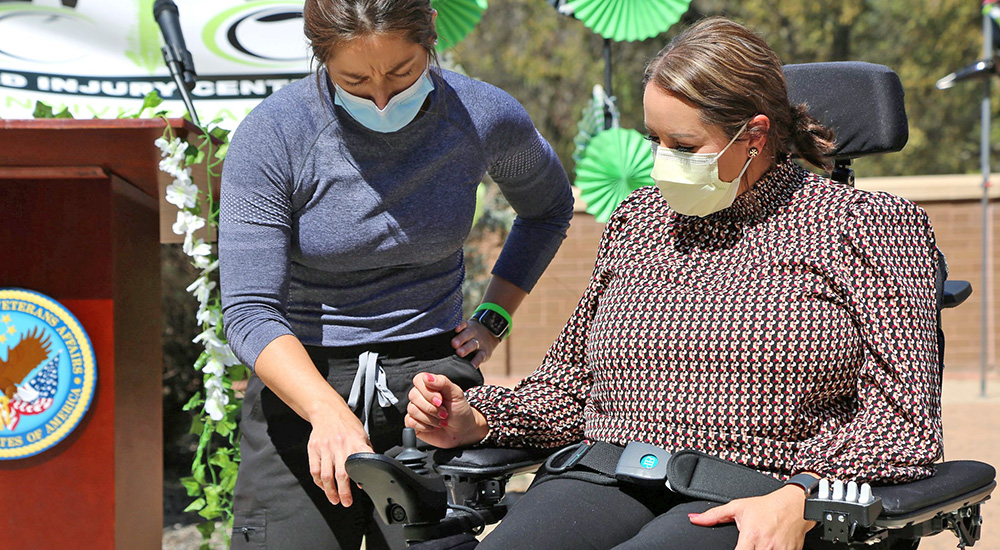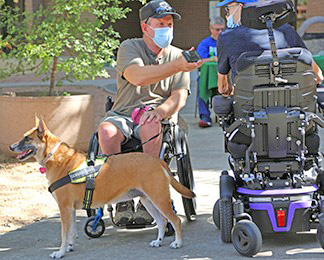Two words heard frequently at the South Texas VA Spinal Cord Injury and Disorder (SCID) unit open house were “family” and “technology.” Both featured speakers and attendees leaned on those themes when talking about their SCID experiences.
South Texas VA interim director Jason Cave opened with a few stories about patients who relied on their families, both birth and spinal cord injury.
A Veteran who was non-verbal was working very hard with his therapists. He finally uttered a few words on Christmas Eve. The staff, excited and in tears, called the family who joined him. The patient told the staff: “Every week, every session was helping. I just couldn’t tell you.”
“A person can be receiving the best health care in the world but the most significant impact on their prognosis is their family support. It’s that social network support, having someone in your corner fighting for you,” Cave said.
Fellow spinal cord injury patient eased transition
That sense of family is what brought SCID patients Robert Preston and Jose Liguez to the open house. “I had a back operation in 2009 and was an SCI patient,” Preston said.
Preston was excited to meet an old friend and fellow patient who took him under his wing when he first went in a wheelchair. He was nervous to use the bathroom in public. Preston explained that he received reassurance and even a transportation van from his fellow Veteran to ease his transition.
Liguez smiled when he saw Sylvia Garcia. He has known her since he started receiving services when the unit opened in 1991. She worked on the unit, has since retired, and still volunteers. Liguez considers her family.
Rose Zimmer was also drawn to the open house, eager to see the patients and staff again after COVID restrictions had shut off many of her volunteer activities. “About a year after my husband passed away, I felt like I wanted to volunteer someplace,” Zimmer said. She pointed out Claudia Surita and Maybelyn Bautista. “Some of the nurses, like the girls there, were his nurses and took great care of him,” Zimmer said.
Technology demonstrations on display
The open house was also about technology, with many demonstrations on display for patients and staff to experience. There was a ping pong robot, advanced mobile chairs, vehicle driving systems and the newest smart beds. Some were not so advanced in design but innovative in delivery, like service dog Kemmerle, a Golden Lab.
Kemmerle was ready to demonstrate her not-so-technological-act of picking up a dropped leash and returning it to its owner, a small task with a huge impact on quality of life.
Technology can be a game-changer for patient and clinicians but can only go as far as the organization lets it. “There were about eight different facilities represented and we quickly began to realize the clinicians needed support to continue to grow,” said Dr. Anne Bailey, director, Clinical Tech Innovation co-lead, VA Extended Reality Network.
Given 10-year life expectancy… 46 years ago
And grow they did. Bailey said the network now involves over 1,250 frontline staff members representing 160 medical centers. It’s the goal to get that technology down to the field to improve the services for Veterans who need it… like Jose Liguez.
Liguez has been with the unit since its inception and has seen technology’s impact on services. “Now it’s really advanced. Even the medication and solutions to problems like bedsores are more advanced,” he said. When he went into the chair 46 years ago, they only gave him a life expectancy of five to 10 years. He attributes his longevity to SCI.
Dr. Divya Singhal, SCID chief, said it will take all of these things and more. “We all can continue to serve our Veterans in a variety of ways, combining the technology, whether it’s virtual reality or more remote care and telehealth. Even newer and more innovative ways of serving needs come with time, longevity and different health care and environmental experiences,” Singhal said. “I hope we can grow our team of collaborators and partners. Just like it takes a village to raise a wonderful child, it takes a village and more to have a wonderful and sustaining health care system that can continue to grow.”
Topics in this story
More Stories
Study underscores important role COVID vaccination can have in protecting Veterans from infection and reducing long-term health consequences
Columbia VA’s robotic surgery teams completed their 800th robotic surgery and are on schedule to hit 1,000 by the end of the year.
In a decentralized clinical trial, Veterans can participate from their own homes or local VA instead of having to travel to a research site.







